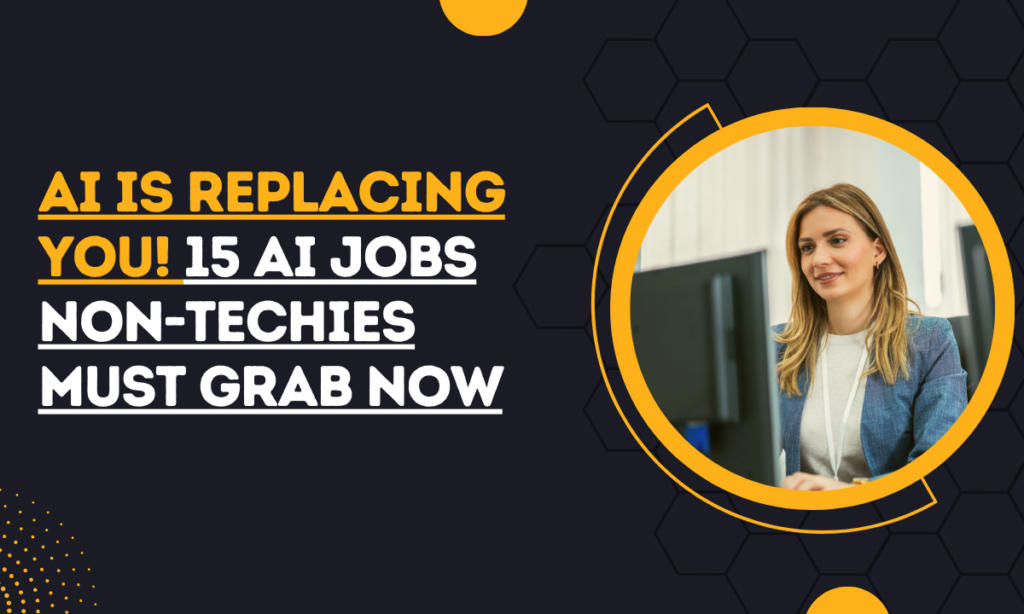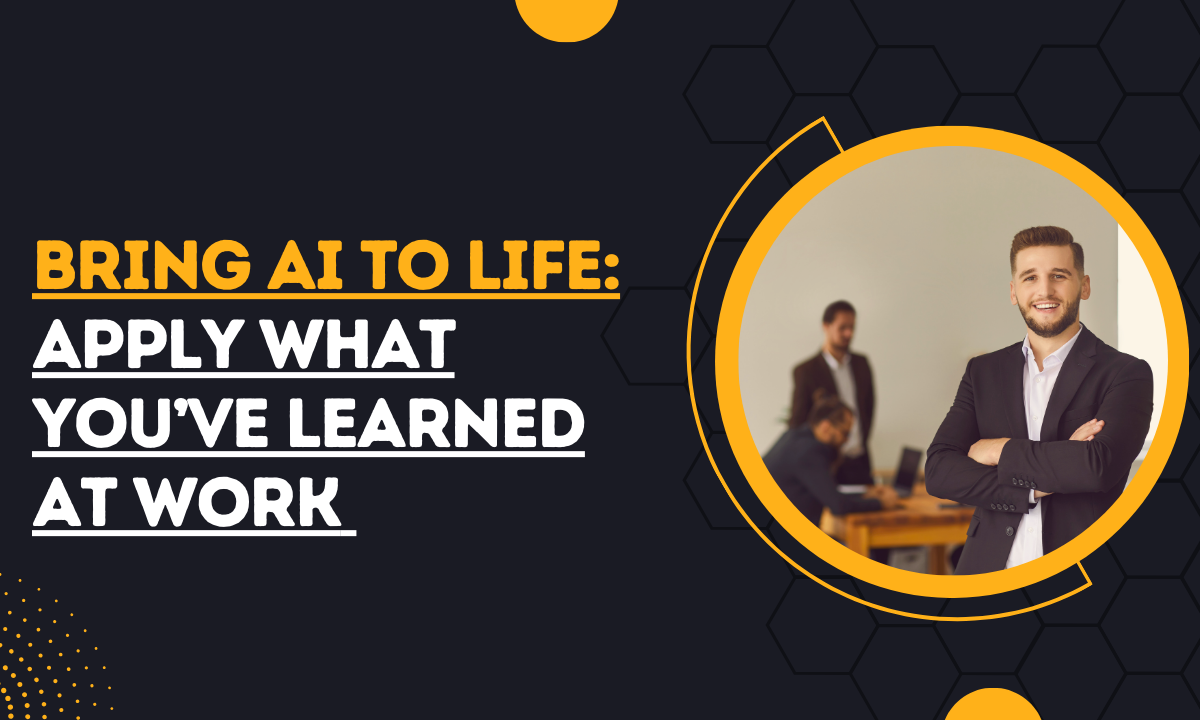Bring AI to Life: Apply What You’ve Learned at Work
In the rush of AI hype, it’s easy to treat artificial intelligence like an abstract idea — a buzzword you nod at in meetings but never actually use. But the magic happens when you bring AI to life in your day-to-day work.
That’s when algorithms stop being “future tech” and start being your personal productivity sidekick.
The difference between knowing AI exists and putting it to work is the same as owning a cookbook versus actually cooking dinner — only one will feed you.
Every day you delay applying what you’ve learned, you’re letting opportunities, time, and competitive advantage slip away.
You don’t need to be a coder, a data scientist, or a Silicon Valley prodigy. You just need curiosity, a willingness to experiment, and the boldness to take your shiny new AI knowledge out for a real-world test drive — today, not “someday.”
Turning AI from Theory into Tangible Wins
The real secret of AI mastery isn’t memorizing technical jargon — it’s using what you know to make something better, faster, or smarter.
You can attend a dozen webinars, binge AI podcasts, or take free courses, but until you click “run” on that chatbot you built, you’re still in the classroom.

Source Image: Brainalyst
Bringing AI to life is about moving from curiosity to commitment.
Think of AI like a gym membership: signing up doesn’t get you fit — showing up does.
It could be as small as using an AI writing assistant to draft client proposals or as bold as setting up a predictive model for sales trends in your industry.
These moments of application are where learning becomes transformation.
And here’s the unexpected twist: you’ll learn more in a single messy, imperfect project than you will in ten polished tutorials.
Why?
Because the moment you apply AI in your unique context, it stops being generic knowledge and starts being yours.
Why Waiting Costs More Than You Think
Here’s the uncomfortable truth: the longer you wait to bring AI to life in your work, the more expensive your delay becomes.
And I’m not just talking about money — though you’ll eventually pay for courses and tools that are free now.
The bigger cost is momentum.
Think of the AI adoption curve like a departing train. Right now, it’s still at the station. You can walk aboard without rushing.
But as it starts to roll away, you’ll have to sprint — and even then, you’ll be competing with everyone else who woke up late.
The “latecomer tax” is real: higher costs, tougher competition, and the need to unlearn outdated workflows before adopting new ones.
Every week you hesitate, someone in your industry is gaining AI experience that will make them more efficient, creative, and attractive to employers or clients.
That’s not a reason to panic — it’s a reason to start.
The good news?
Even small, early steps compound into big advantages over time.
Making AI Work for Non-Tech Roles
One of the biggest misconceptions about AI is that it’s a playground for programmers and data scientists only.
Not true. AI is for non-techies as well.
You can bring AI to life in a teaching job, a bakery, a law office, or a fitness studio.

Image Source: AI Is Replacing You! 15 AI Jobs Non-Techies Must Grab Now
AI is like electricity — it doesn’t care if you’re powering a skyscraper or a toaster, it just works where you plug it in.
Teachers can generate custom lesson plans tailored to different learning styles. Small business owners can automate inventory tracking or generate social media content in minutes.
Accountants can use AI tools to flag unusual transactions before they become expensive problems.
The point is, AI adapts to you, not the other way around. Your role doesn’t have to be “technical” for AI to make an impact.
The moment you align AI tools with your daily tasks, you’ll start to see hours saved, errors reduced, and new opportunities unlocked — no coding required.
Practical AI Playbook for Non-Tech Roles
| Role | AI in Action | Practical Benefit |
|---|---|---|
| Teacher | Use ChatGPT or education-specific AI to create personalized lesson plans for different student levels in minutes. | Saves planning time, improves student engagement, and supports diverse learning needs. |
| Bakery Owner | Automate daily inventory checks and predict ingredient needs using AI-based POS systems. | Prevents stockouts, reduces waste, and improves profit margins. |
| Law Office Assistant | Use AI document analysis tools to quickly summarize contracts and highlight key clauses. | Cuts review time, reduces oversight risk, and increases billable efficiency. |
| Fitness Coach | Generate customized workout plans and nutrition advice for clients using AI health apps. | Enhances personalization, boosts client satisfaction, and frees time for more sessions. |
| Accountant | Employ AI accounting software to flag unusual transactions or detect anomalies. | Prevents costly errors, strengthens compliance, and improves client trust. |
| Social Media Manager | Use AI to auto-generate content ideas, captions, and post schedules. | Maintains consistent online presence with less effort, boosting reach and engagement. |
Learning by Doing — The Fast-Track to AI Confidence
You can watch someone else cook for hours, but until you step into the kitchen and risk burning the pasta, you don’t really learn.
The same is true with AI.
The fastest way to feel confident is to experiment in a safe, low-stakes environment where failure is just feedback.
Set yourself a 7-day challenge: each day, apply AI to a single task you normally do manually.
Maybe that’s summarizing a long report, generating captions for a photo, or organizing your email inbox with smart filters.
You’ll be amazed at how quickly you move from “What if?” to “What’s next?”
The beauty is that AI tools often come with built-in tutorials or templates, so you’re never starting from scratch.
By the end of a week, you’ll have not just learned — but lived — the possibilities of AI. And that kind of experiential learning sticks.
Small Experiments, Big Payoffs
You don’t need to overhaul your entire workflow in one dramatic AI makeover.
In fact, the smartest way to bring AI to life is through small, strategic experiments that stack up over time.
Try this: choose one pain point in your workday — maybe repetitive emails, slow data entry, or tedious scheduling — and see how AI can handle it.
Keep the experiment tiny and measurable.
Did it save you 10 minutes?
Multiply that by 200 workdays, and suddenly you’ve gained over 33 hours a year. That’s nearly a full workweek you can redirect toward higher-value tasks.
These bite-sized wins also boost your confidence, which makes you more willing to test AI in bigger, more complex areas.
Like a snowball rolling downhill, each small success gathers momentum until AI is woven naturally into your professional rhythm.
Overcoming the “I’m Not Technical” Mindset
The biggest barrier to AI adoption isn’t cost, time, or access — it’s mindset.
Too many professionals still tell themselves, “I’m not technical” as if it’s a permanent identity. But bringing AI to life doesn’t require you to become an engineer.
Think of AI tools like kitchen appliances.
You don’t need to know how a blender works internally to make a smoothie. You just need to know which buttons to push.
The same goes for AI — most tools are designed for ease of use, with intuitive dashboards, drag-and-drop features, and plain-language prompts.
By shifting your mindset from “I can’t” to “I’ll try,” you turn AI from an intimidating mystery into an everyday utility.
And once you start using it, you’ll realize that your lack of “techiness” isn’t a barrier — it’s an advantage. You’re bringing a fresh, practical perspective that tech experts sometimes overlook.
The Compound Effect of Early Adoption
Every day you integrate AI into your work, you’re building invisible equity in your future career.
Like compound interest in a savings account, the skills you develop now will keep paying dividends — in promotions, business growth, and professional security.
Early adopters don’t just get ahead; they stay ahead because each new AI capability builds on what they already know.
When a new tool emerges, they recognize its potential faster and adapt more easily.
Late adopters?
They’re still trying to master the basics.
By the time AI becomes standard in your industry, the early adopters will be shaping best practices — not scrambling to learn them.
This is why the smartest professionals treat AI adoption like investing: the earlier you start, the greater your returns.
FAQs
Q: Do I need coding skills to bring AI to life in my job?
Not at all. Most modern AI tools are built for non-technical users.
Q: How soon can I expect results after applying AI?
Often immediately — even small tasks like summarizing text can save hours.
Q: Can AI really help in creative professions?
Absolutely. Writers, designers, and marketers use AI to brainstorm, edit, and refine ideas.
Q: What if I try an AI tool and it doesn’t work well?
That’s part of the process. Use it as feedback and try a different tool or approach.
Q: Will AI replace my job if I start using it?
No — using AI makes you more valuable by boosting productivity and freeing time for higher-value work.
Q: How much time should I spend learning AI tools each week?
Even 15–30 minutes a day can keep you ahead. Consistency matters more than cramming once in a while.
Q: Can I integrate AI with the tools I already use?
Yes. Many AI platforms plug into email, spreadsheets, design software, and project management apps for seamless workflows.
Related Posts
Become an AI Power User in 2025: An Easy Path for Non-Techies
You don’t need a tech degree — just curiosity and consistency. Learn the tools, master the shortcuts, and let AI work for you.
How Long Does It Take to Learn AI for a Non-Tech Person?
With focused effort, you can see results in weeks, not years. The key is starting small and building practical skills daily.
The Secret AI Learning Hack for Non-Techies to Stay Ahead!
Leverage AI to teach you AI — it’s faster, easier, and tailored to your pace. You’ll learn more in a month than most do in a year.
Top 5 AI Apps for Mental Focus
From task automation to distraction blocking, these apps sharpen your edge. AI can help your brain stay clear, calm, and in control.
Conclusion
The fastest way to bring AI to life is to stop thinking about it as “technology” and start treating it as a tool you can wield today.
You don’t need perfect conditions, a big budget, or a tech degree — you just need a willingness to act.
Every experiment you run, every task you automate, and every insight you gain adds to your professional arsenal.
We are at a rare point in history where the gap between AI potential and AI adoption is still wide enough for bold, curious people to leap ahead. That gap is closing fast. Whether you take your first step by automating an email or creating an AI-powered presentation, the point is to start.
Because in a few years, the question won’t be “Should I learn AI?” — it will be “Why didn’t I start sooner?”
TL;DR — Key Takeaways
- Start using AI now — waiting increases costs and competition.
- Small experiments build skill, confidence, and measurable time savings.
- AI works in any profession, not just tech-heavy roles.
- Mindset is the biggest barrier — not lack of skills.
- Early adoption compounds into long-term career advantage.
- Learn faster by applying AI in real, daily tasks.

